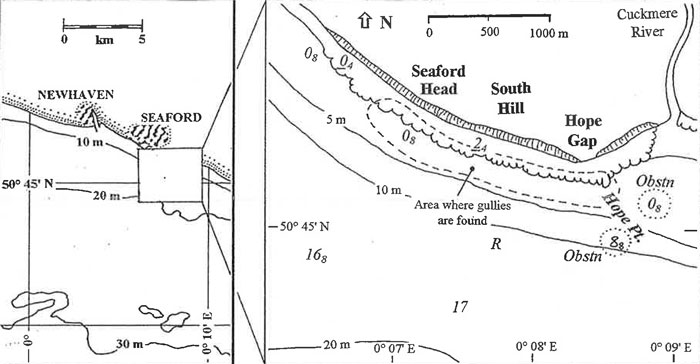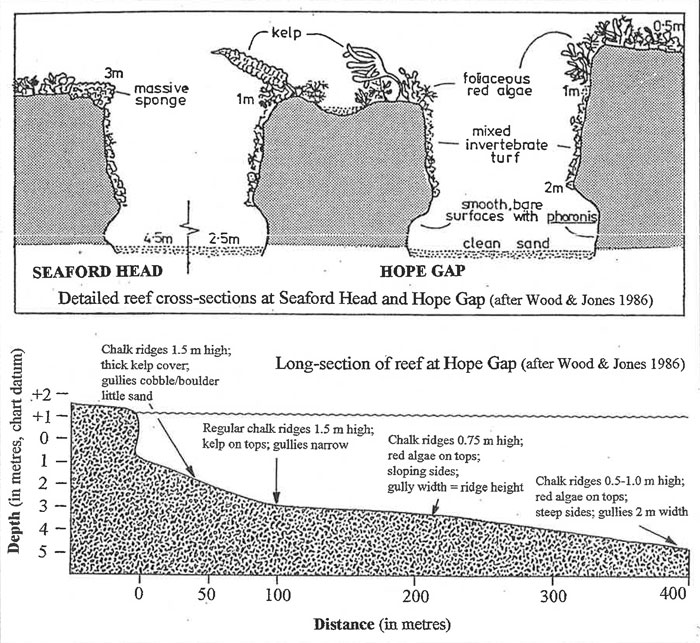SUSSEX MARINE SITES OF NATURE CONSERVATION IMPORTANCE
| Site: Seaford Head Gullies | Ref. No. 11 | ||||||
| Location: Between Seaford Head and Hope Point, just west of Cuckmere Haven | Other conservation designation?: Within the Seven Sisters Voluntary Marine Conservation Area |
||||||
| Lat./Long. position of centre of site: 50° 45' 20" N 0° 7' 50" E |
OS grid ref. of centre of site: TV 500 972 |
Author: Robert Irving |
|||||
| Sea bed type: Shallow, near-shore chalk gullies and ridges. |
Depth range (below chart datum): 0-5 m |
Date identified: January 1996 |
|||||
Summary
At the edge of the wave-cut chalk platform between the Martello tower to the west of Seaford Head and Hope Point, lie a series of chalk gullies and ridges which run perpendicular to the line of the coast. Similar gullies are found at other sites along this stretch of coast (for instance, to the west of Newhaven and at Belle Tout), but are less well developed than the ones found at Seaford Head/Hope Point. The gullies extend from just above low water mark out to about 600 m offshore. Generally, the height of the ridges decreases with distance from the shore and increasing depth.
Biological Description
In the shallowest areas (0.5 m below chart datum) closest to the edge of the wave-cut platform, the chalk ridges lining the gullies are about 1.5 m high with a 'thick' kelp cover (reported from Hope Gap), mostly of Laminaria saccharina but with some L. digitata too. (The presence of L. saccharina is unusual in such an exposed location: one might expect to find L. hyperborea here, but this species is absent). The kelp does not extend below 2.5 m (bcd); beyond this, upward-facing surfaces are dominated by smaller brown and red seaweeds such as Taonia atomaria, Calliblepharis ciliata and Ceramium rubrum. Algal cover becomes sparse below 5 m (bcd) and is absent below 7 m (bcd).
On all vertical or steeply sloping chalk bedrock surfaces below the dense algal zone, animal communities are dominant. On upper surfaces of the chalk ridges large growths of the breadcrumb sponge Halichondria panicea are present, and in less exposed places, the sponges Halichondria bowerbanki and Esperiopsis fucorum. The sides to the ridges have a covering of animal turf, made up largely of bryozoans (Bugula spp.) and hydroids, with various tubicolous worms including Sabellaria spinulosa, Pomatoceros triqueter and Filograna implexa/Salmacina dysteri. The tubes of these worms may well help to prevent erosion of the soft rock. The lower sides of the ridges are affected by the movement of sand and pebbles from the gully floor, and are often bare. There is, however, a narrow (10-20 cm wide) band between the animal turf and the bare rock which is colonised by large numbers of the horseshoe worm Phoronis hippocrepia. Other major burrowing organisms in the chalk include the polychaete Polydora ciliata and the piddocks Pholas dactylus, Barnea parva and Hiatella arctica. The gully floors are of chalk overlain by silty muddy sand with occasional cobbles and pebbles. Mobile species include various crustacea such as lobster Homarus gammarus, edible crabs Cancer pagurus and velvet swimming crabs Necora puber. Common fishes associated with the reefs include the tompot blenny Parablennius gattorugine, long-spined sea scorpion Taurulus bubalis and the leopard spotted goby Thorogobius ephippiatus (near the eastern limit of its distribution).
References:Wood, C. (ed) 1984. Sussex Sublittoral Survey: Selsey Bill to Beachy Head Marine Conservation Society, SE Branch |
|||||||
| Sussex SEASEARCH dive nos.: 95/34, 35, 36, 40, 41, 78, 80, 81, 106, 107 | |||||||
| Sussex Sublittoral Survey site no.: 56 | |||||||
Site Location

Diagrammatic representation of site: Seaford Head Gullies


:Link to this page
Copyright Sussex Biodiversity Records Centre © 2025